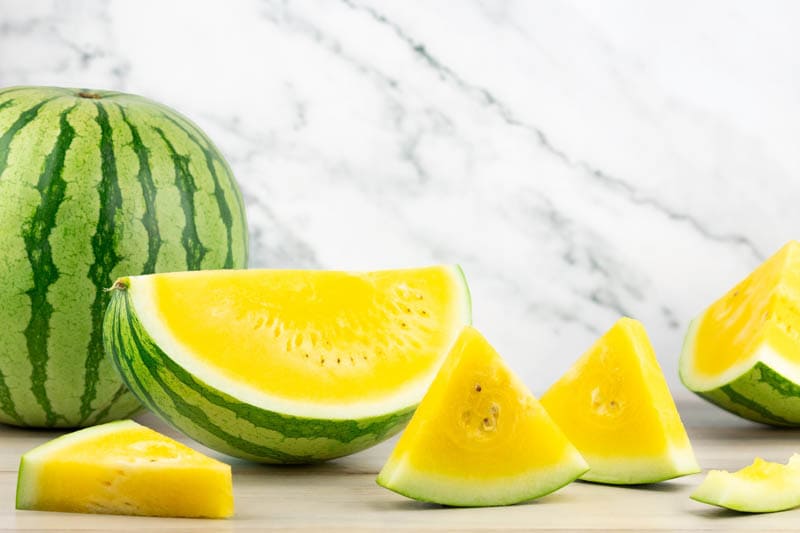Picture this: you’re at the farmers market on a sweltering July morning, eyeing those familiar striped green watermelons. The vendor hands you a knife and says, “Try this one.”
You slice through the familiar green rind, expecting that burst of pink-red sweetness, but instead—sunshine. Pure, golden sunshine stares back at you from inside what looks like any other watermelon.
Welcome to the wonderful world of yellow watermelon, a fruit that’s been quietly stealing hearts and confusing shoppers for millennia. If you’ve never encountered this golden beauty, you’re not alone, but you’re definitely missing out.
By the end of this guide, you’ll know exactly what makes these melons special, where to find them, and why they might just become your new summer obsession.
The Science Behind the Golden Glow
The magic of yellow watermelon isn’t magic at all—it’s beautifully simple science. Traditional red watermelons get their rosy hue from lycopene, the same powerful antioxidant that makes tomatoes red and gives pink grapefruit its blush. Yellow watermelons simply don’t contain this pigment.
Instead, they’re packed with beta-carotene, the same compound that gives carrots their orange color and sweet potatoes their golden flesh. This difference in pigmentation creates more than just a color change—it produces a noticeably sweeter flavor profile with subtle honey and apricot notes that many people find irresistible.
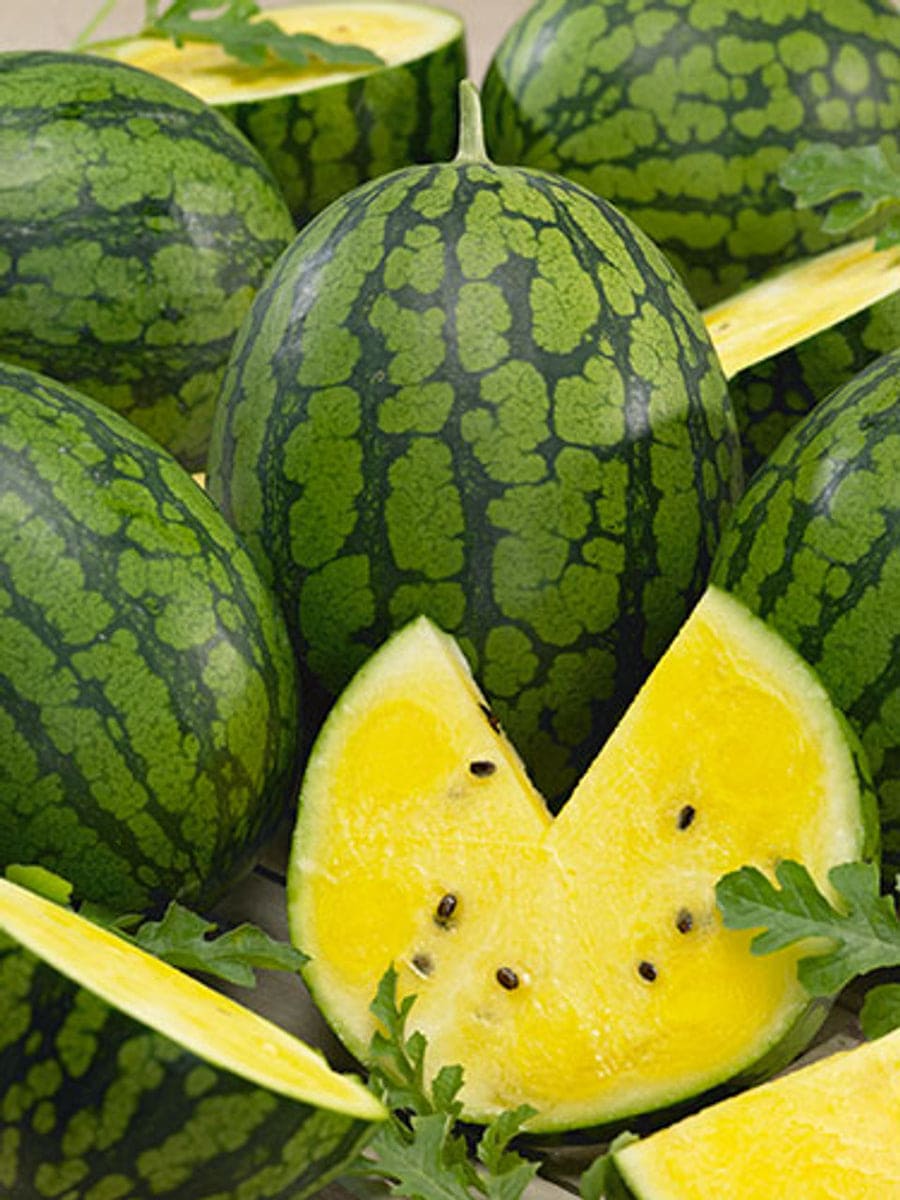
Think of it like nature’s own color-changing experiment, except this one happened thousands of years before we understood the chemistry behind it.
A Sweeter Story: Taste and Texture Revealed
If you’re imagining some exotic, unfamiliar flavor, prepare to be pleasantly surprised. Yellow watermelon delivers the same gloriously crisp, juicy texture we love about traditional watermelon, but with an enhanced sweetness that feels like summer distilled into fruit form.
The difference is subtle but unmistakable—imagine your favorite watermelon with a whisper of honey and a hint of apricot warmth. Some varieties lean toward floral notes, while others carry a more pronounced honeyed sweetness. The texture remains perfectly familiar: light, refreshing, and satisfyingly crisp with each bite.
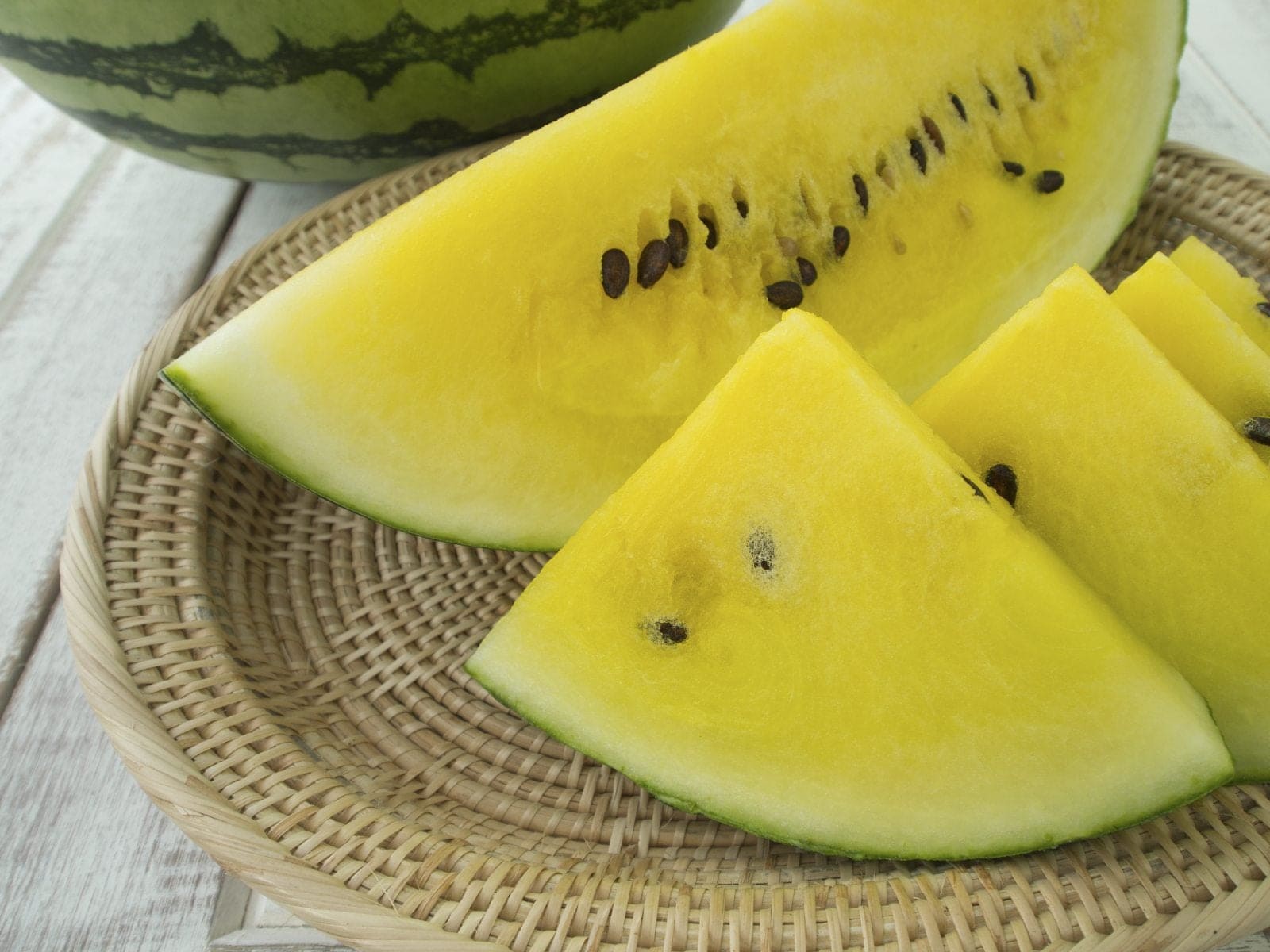
I remember my first encounter with yellow watermelon at a roadside stand in Georgia. The farmer, weathered hands and knowing smile, insisted I try “the yellow one.” I was skeptical—watermelon was watermelon, right? One bite changed everything. It was like tasting summer for the first time, familiar yet wonderfully new.
The Ancient Origins: Older Than You Think
Here’s where yellow watermelon gets really interesting: it’s actually the original. While we often think of red watermelon as the “classic” variety, yellow watermelons were being cultivated in Africa over 5,000 years ago, long before their red relatives appeared.
Ancient Egyptians treasured these golden fruits so much they included them in pharaohs’ tombs, believing they would provide sustenance in the afterlife. Archaeological evidence shows watermelon seeds in King Tutankhamun’s tomb, and wall paintings from ancient Egypt depict what appear to be yellow watermelons alongside other precious foods.
The Africans called them “desert kings” for their ability to provide crucial hydration in arid climates.
The red varieties we know today emerged through centuries of selective breeding as farmers worked to enhance sweetness, size, and other desirable traits.
As lycopene content increased through this natural selection process, watermelons gradually shifted from yellow to the pink and red varieties that dominate modern markets. This means yellow watermelons aren’t some newfangled hybrid—they’re actually closer to the original fruit than their red cousins.
Meet the Golden Family: Understanding the Varieties
Not all yellow watermelons are created equal, and understanding the differences can help you choose the perfect variety for your needs.
1. Yellow Crimson is the variety you’re most likely to encounter at specialty stores. It looks identical to the popular red Crimson Sweet variety from the outside but surprises you with bright yellow flesh that’s notably sweeter than its red counterpart. This variety typically weighs 10-15 pounds and offers the perfect introduction to yellow watermelons.
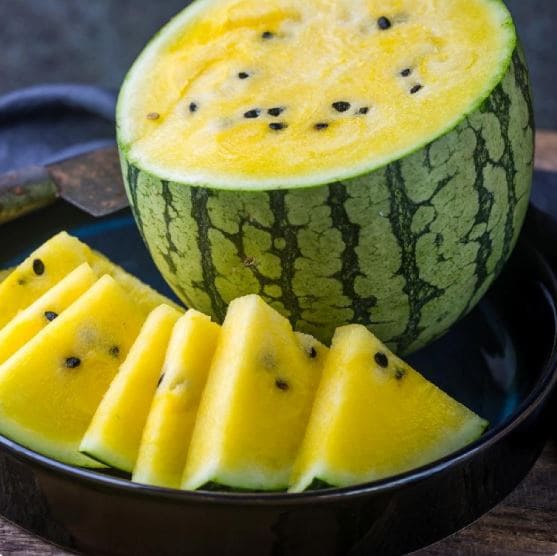
2. Buttercup Yellow takes sweetness to the next level with one of the highest sugar contents of any watermelon variety. This seedless hybrid makes it perfect for desserts or anyone with a serious sweet tooth. The dense, creamy texture sets it apart from other varieties, and most weigh between 14-16 pounds.
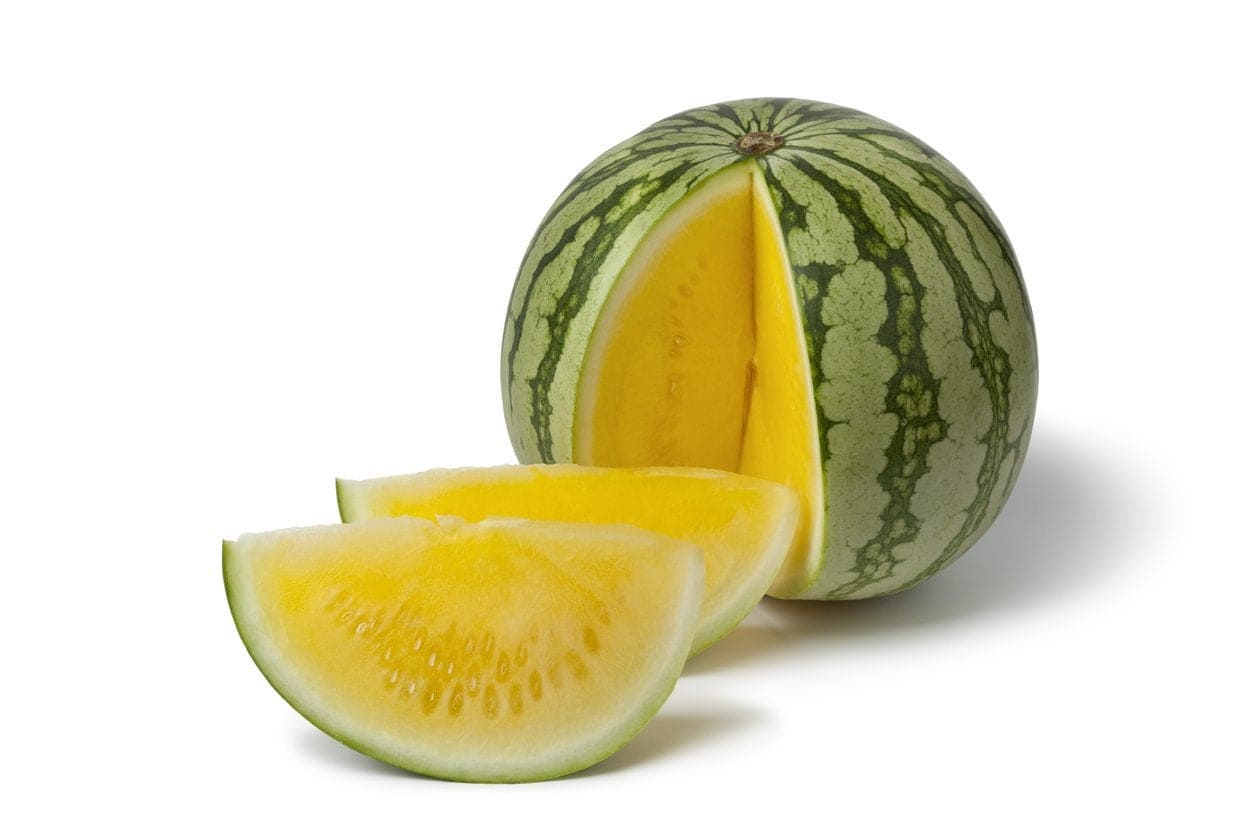
3. Yellow Doll is the compact overachiever of the group. Weighing in at just 5-7 pounds, these small melons mature quickly and pack intense sweetness into a manageable size—perfect for small households or those wanting to try yellow watermelon without committing to a massive fruit. They’re also excellent for container growing.

4. Desert King earns its name honestly, originally cultivated in arid regions where its drought resistance made it invaluable. This variety can handle challenging growing conditions better than most watermelons.
Its flesh tends toward orange-yellow and carries distinctive honey-apricot notes that some people compare to cantaloupe, though the texture remains purely watermelon.
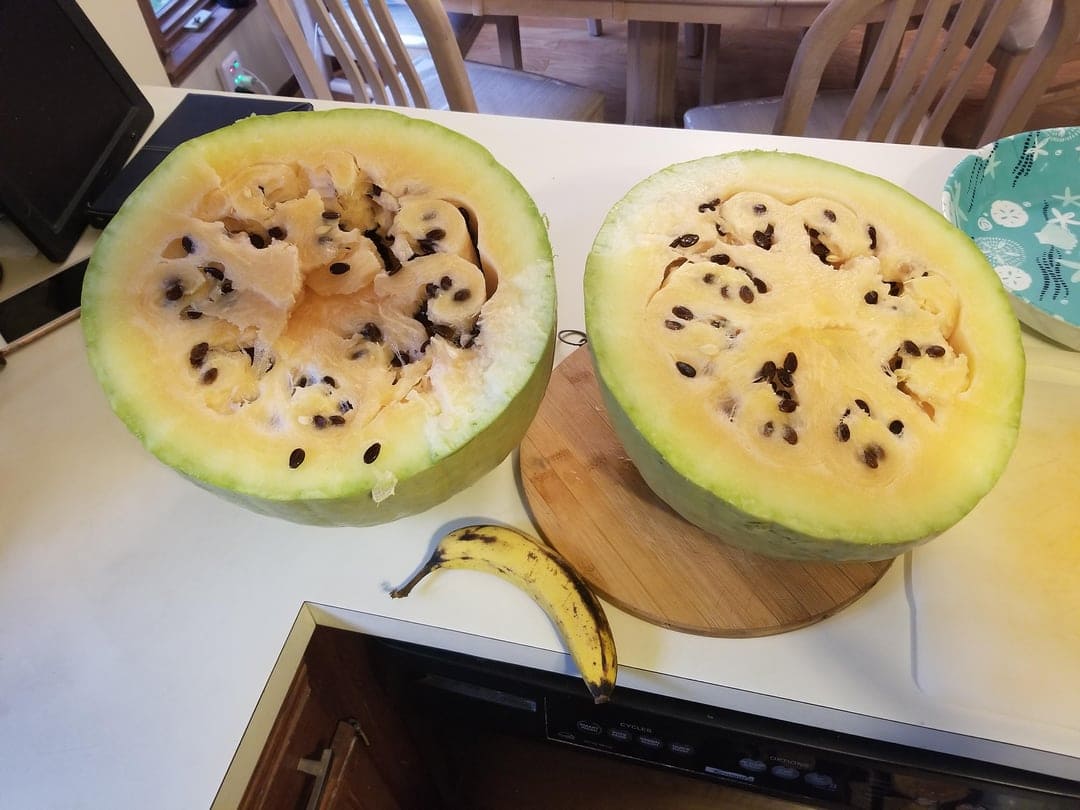
5. Yellow Flesh Black Diamond rounds out the family with a more subdued sweetness that closely matches red watermelons. Its dark green, almost black rind makes it easy to identify, and it’s an excellent choice for those wanting yellow color without overwhelming sweetness. These tend to be larger melons, often reaching 20-25 pounds.

👉 Discover 35+ Apple Varieties With Selection Tips & Their Perfect Uses
Nutritional Powerhouse in Golden Packaging
Don’t let the candy-like sweetness fool you—yellow watermelons are nutritional champions. Like their red relatives, they’re about 92% water, making them fantastic for hydration during hot summer days. A cup contains only about 46 calories, so you can indulge without guilt.
The beta-carotene that creates their golden color converts to vitamin A in your body, supporting immune function, eye health, and skin vitality. They’re also rich in vitamin C, providing about 25% of your daily needs in a single cup.
This combination makes yellow watermelon particularly beneficial for maintaining healthy skin and supporting your immune system during summer months when you need it most.
While yellow varieties don’t contain the lycopene found in red watermelons, they more than compensate with higher beta-carotene levels. You’re essentially choosing between two different types of cellular protection—both excellent options with slightly different pathways to supporting your health.
The natural electrolytes and high water content make yellow watermelon an ideal post-workout snack or a refreshing way to stay hydrated during outdoor activities. The natural sugars provide quick energy without the crash associated with processed sweets.
The Hunt: Where to Find These Golden Treasures
Finding yellow watermelon requires patience and a bit of detective work, but the treasure hunt is part of the adventure. Your best bet is local farmers markets, especially during peak season from June through September in most regions.
However, in warmer climates like parts of California and Florida, you might find them available from late spring through early fall.
Specialty grocery stores and natural food markets often carry them when they’re in season. Trader Joe’s has become somewhat famous for stocking yellow watermelons during summer months, though availability varies significantly by location and timing. Some Whole Foods locations and Asian markets also carry them periodically.
Call ahead or ask the produce manager at your regular grocery store—sometimes they can special order them if there’s enough interest. Don’t be surprised if you need to visit several stores or wait for the right season. Yellow watermelons typically cost about the same as premium red varieties, but the main challenge is availability rather than price.
When you do find them, selection follows the same rules as choosing red watermelons, with a few additional considerations. Look for a heavy melon with a creamy yellow “ground spot” where it rested on the earth—this should be distinctly yellow, not white or barely visible.
Give it a gentle tap with your knuckles; you want a deep, hollow sound rather than a dull thud. The stem should be dry and brown, not green, and the rind should have a matte finish rather than a glossy sheen.
Beyond the Slice: Creative Applications
The stunning golden color of yellow watermelon opens up culinary possibilities that go far beyond simple snacking. The enhanced sweetness makes it particularly versatile in both sweet and savory applications.
Create an eye-catching fruit salad by combining yellow watermelon cubes with red varieties, fresh mint, and crumbled feta cheese. The color contrast alone will have guests asking for the recipe. The sweeter profile of yellow watermelon balances beautifully with the salt in feta and the freshness of mint.
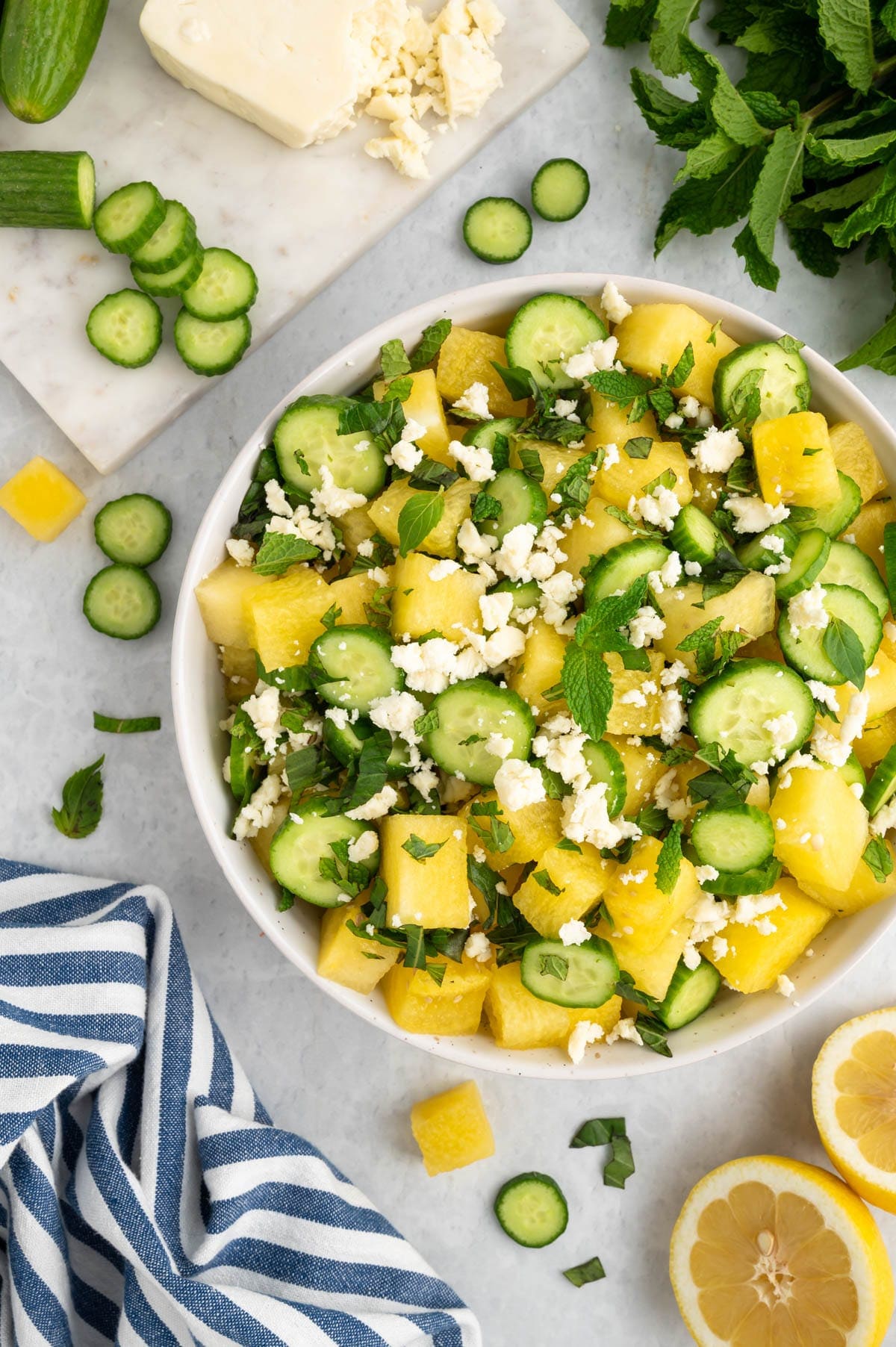
For beverages, yellow watermelon creates stunning agua frescas and cocktails. Blend the flesh with lime juice and fresh mint for a drink that tastes like liquid sunshine.
The golden color is particularly beautiful in clear glasses with ice, and the natural sweetness often eliminates the need for added sugars. Try it in margaritas, where the honey notes complement tequila beautifully.
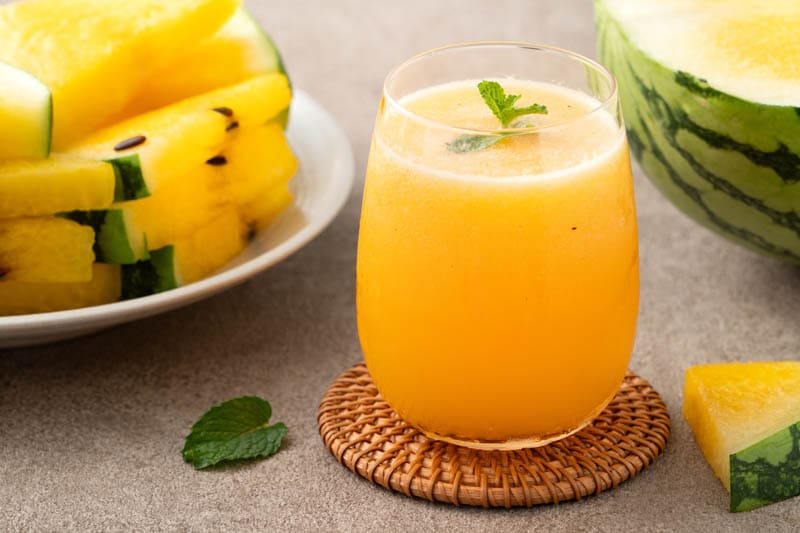
Grilling yellow watermelon caramelizes its natural sugars and intensifies those honey notes that make it special. Simply slice thick wedges, brush lightly with olive oil, and grill for 2-3 minutes per side. Serve with a sprinkle of sea salt and fresh herbs for an unexpected side dish that pairs wonderfully with barbecued meats.
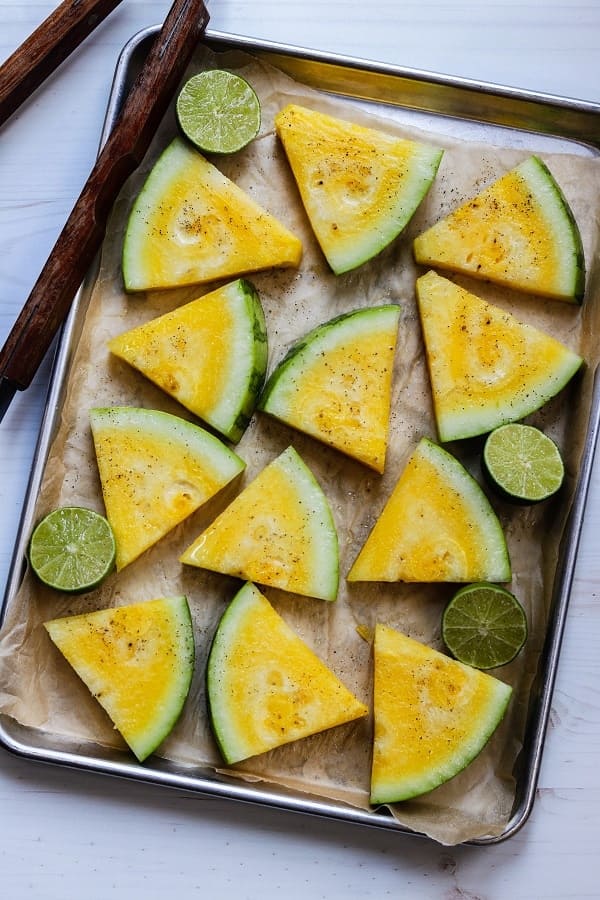
👉 Here’s How to Dehydrate Apples at Home: Easy Steps for Perfect Results
Yellow watermelon gazpacho offers an elegant summer starter that surprises guests with its golden color. The slightly sweeter flavor profile adds complexity to this classic cold soup, and you can play up the honey notes with a drizzle of good olive oil and fresh herbs.
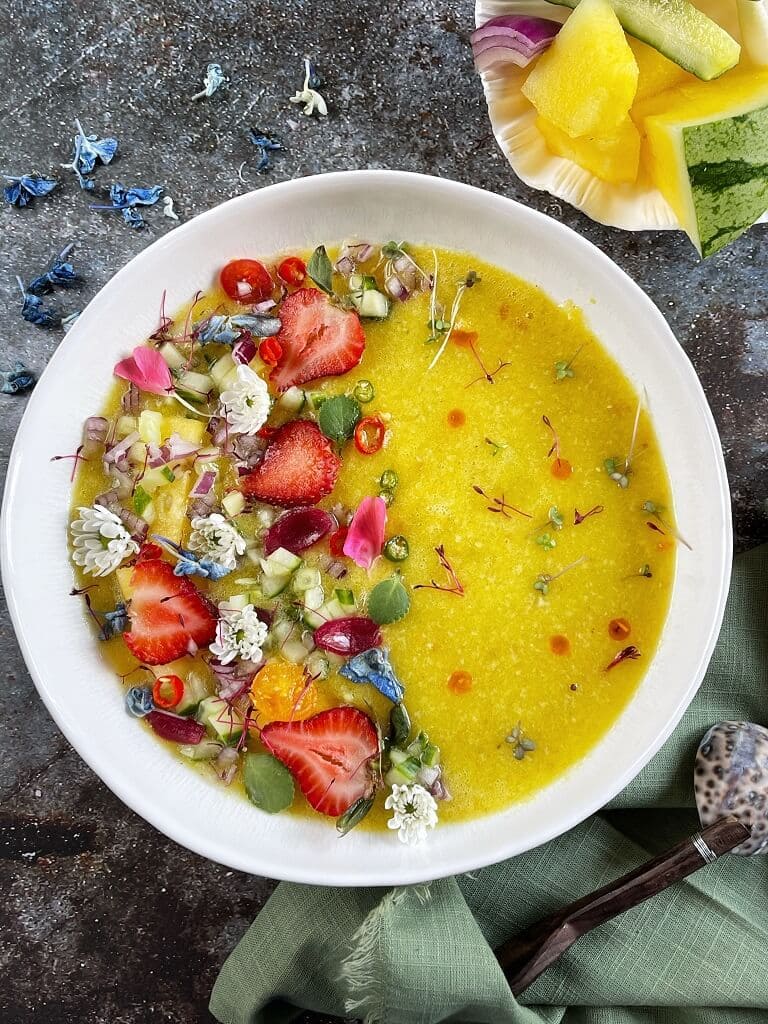
Don’t overlook the rind, either. Yellow watermelon rinds can be pickled just like red varieties, creating a sweet-and-tangy condiment that’s perfect for summer entertaining. The pickling process tames the rind’s natural bitterness while preserving its crisp texture.
👉 Learn about Banana Peel Fertilizer: Truth vs. Myths About This Popular Garden Hack
Growing Your Own Golden Garden
If you’re feeling ambitious, yellow watermelons aren’t significantly more challenging to grow than red varieties, though they do have some specific requirements worth noting. They need the same basic conditions: full sun, well-draining soil rich in organic matter, and consistent moisture until the fruits reach tennis ball size.
Most varieties require 80-100 days from planting to harvest, with Yellow Doll maturing fastest at around 68 days. Start seeds indoors 2-3 weeks before your last frost date, then transplant seedlings after soil temperatures consistently reach 70°F. Yellow watermelons are particularly sensitive to cold soil, so don’t rush the transplanting process.
Space plants 6 feet apart in all directions—these vines spread extensively and need room to roam. Many gardeners find success growing compact varieties like Yellow Doll in large containers or raised beds where space is limited. The key is providing adequate soil volume and drainage.
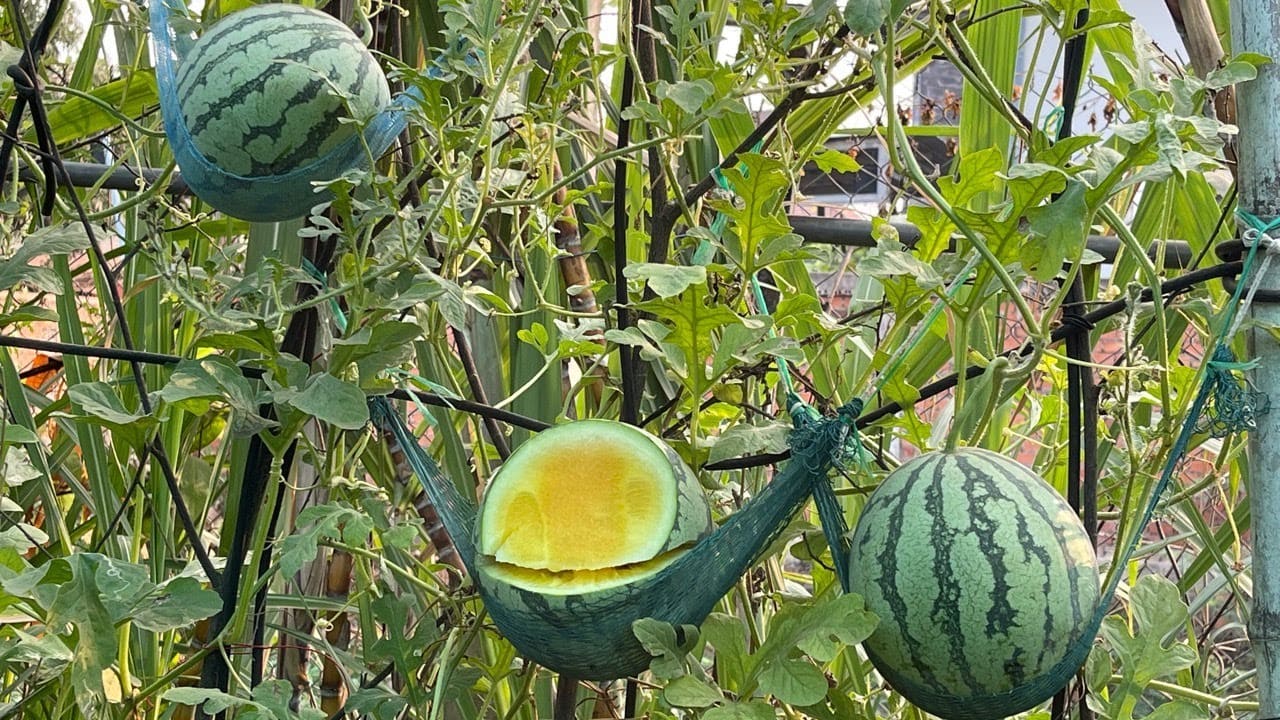
Watch for the same ripeness indicators you’d use for red watermelons: the ground spot turns creamy yellow, the nearest tendril dries and turns brown, and the fruit sounds hollow when tapped. Yellow varieties can be trickier to judge because the color change is less dramatic than red varieties, so rely more heavily on the sound test and tendril indicators.
One advantage of growing your own is access to varieties that rarely appear in stores. Seeds for heritage varieties like Mountain Sweet Yellow or Desert King can be ordered online, giving you access to flavors and characteristics that commercial growers often bypass in favor of shipping-friendly varieties.
👉 Here’s How to Grow Watermelons: A Step-by-Step Guide for Sweet, Juicy Harvests
Common Questions Answered
- Are yellow watermelons genetically modified?
Absolutely not. Yellow watermelons are completely natural and actually predate red varieties by thousands of years. They’re the result of traditional selective breeding, not genetic modification.
- Do yellow watermelons cost more than red ones?
Pricing varies by location and season, but yellow watermelons typically cost about the same as premium red varieties. The main difference is availability rather than price.
- Can I use yellow watermelon in any red watermelon recipe?
Yes, they’re completely interchangeable in recipes. The slightly sweeter flavor might actually improve some applications, particularly in beverages and desserts.
- How long do yellow watermelons keep?
Whole yellow watermelons store the same as red varieties—up to two weeks at room temperature or three weeks refrigerated. Once cut, use within 3-5 days.
- Are there other colored watermelons?
Yes! In addition to red and yellow varieties, you can find orange-fleshed watermelons and even some with white flesh. There are also varieties with striped or swirled flesh combining multiple colors.
- Do the seeds taste different?
The seeds from yellow watermelons are identical to red watermelon seeds and can be roasted and eaten the same way. Many yellow varieties are also available in seedless options.
👉 Find out on Can Chickens Eat Sunflower Seeds? Everything You Need to Know
Your Golden Summer Adventure Awaits
Yellow watermelon represents everything wonderful about exploring food: the surprise of discovery, the joy of tasting something familiar yet new, and the satisfaction of finding a perfect summer treat. These golden beauties offer enhanced sweetness and visual appeal while maintaining all the refreshing qualities we love about traditional watermelon.
Whether you encounter your first yellow watermelon at a farmers market, grow your own from seed, or finally track one down at a specialty store, you’re participating in an ancient food tradition that spans thousands of years and continents.
You’re also joining a growing community of food enthusiasts who appreciate the subtle differences that make eating an adventure.
This summer, when you’re planning your next fruit adventure, consider adding yellow watermelon to your list. Start by calling local farmers markets or specialty stores to ask about availability. Don’t be discouraged if it takes a few tries—the hunt is part of the experience, and the reward is worth the effort.
Your taste buds will thank you for the upgrade, your guests will be impressed by the unexpected golden color, and you might just discover your new favorite summer obsession hiding in plain sight behind that familiar green rind. The best food experiences are always better when shared, so don’t forget to introduce others to your golden discovery.
